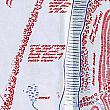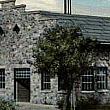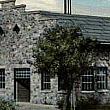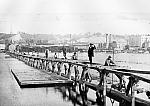
Grand Rapids Water Story, 19th Century, Part IV
The Story of the Hydraulic Water Company
The Hydraulic Water Company’s present source of supply is the ground water from the springy land immediately adjacent to the pump house on the Canal street gravel road. This land is about twenty acres in extent and lies nearly midway between the city limits and the Soldiers’ Home reservation. It extends from the road to the river.
To the east of the gravel road the land runs high, gradually rising toward the hills in the distance. The water from the higher ground naturally drains toward the river. Much of it comes to the surface in the Hydraulic Company’s property. Tile drains tap the various springs and carry a considerable portion of the ground water to a large well located just southwest of the pump house.
The well is about thirty feet in diameter and twenty feet in depth. It is constructed of brick and concrete, and is covered by a conical wooden structure, that is now rotten and dilapidated. The well is built directly over a large spring, and the water from this bubbles up through the bottom. On the south side is an inlet pipe that brings water from the springs to the south. At the north side is another inlet pipe that brings water from the springs to the north of the well.
There is also an inlet from the west. It is claimed by employes (sic) of the Hydraulic company that this inlet formerly brought water from a small creek, that has now dried up. The inlet itself is also dry at the present time.
The Grand River Connection Charge
Charges have been made – though not proven – that this well also has a connection with Grand River. Officials and employes (sic) of the company staunchly insist that this charge is false. The visible evidence is in their favor.
When the well was examined by The Press the only inlet from the direction of the river was found to be dry. This inlet was toward the top of the well, and apparently above the normal level of the river. Even if it came from the river – which is denied – it could apparently be used only in times of high water. In such times the springs furnish plenty of water.
Moreover, the water in the well was dark and mucky, the natural color of water coming from gravel and muck, and collected in a time-stained well. On the other hand water coming from the river into a small well on lower ground a short distance northwest of the pump well was yellow and muddy, the color of the water in the river itself, which was somewhat swollen by recent rains. The water in this small well is used on the condenser of one of the pump engines. It is insisted that it does not get into the main well or into the pumps themselves.
Black Water and Yellow Water
This river well is a comparatively small affair. It is connected with the river by an elongated box. The marked difference in the color between the river water and the water in the pump well is Argument Number Two.
The third argument, and the most logical of all, is the fact that there is a large quantity of spring water on the Hydraulic Company’s property that is not now utilized. It would seemingly be easier and more consistent to run this waste water into the well, than go to the trouble of “polluting” the ground water with river water. A comparatively short distance north of the well a large spring of clear water bubbles to the surface, forming a good sized stream.
Part of the water from this spring is now conducted by tile to the well, but a considerable part of it escapes to the river. This entire stream could be turned into the well if needed without great expense.
Plenty of Spring Water to Spare
Besides this one large stream there are smaller springs on the property that do not now contribute their full quota of water to the well. If the company were pressed for more water to supply its pumps it could increase the quantity without going to the river.
The wall, when viewed by The Press, was not particularly immaculate, although it was not discolored as was the river water. A small mud turtle and a frog were swimming around in it. There were bits of floating matter such as often found in springs. The water was not clear as crystal. It was remarked by an officer of the company that the only cleaning that the well is given is the skimming off of the surface occasionally.
The top of the well is above the usual river high water mark. Last winter, it is stated, the flood water came so high that it went over the top and into the well. The engineer, who has been at the plant ten years, says this was the first time the water had ever flowed from the river over the well. It is claimed that the only way river water can ordinarily get into the well is by mingling with the spring water in flood times. It is admitted that in flood season the water in the well is sometimes colored.
What is Pumped in a Day
It is claimed that the supply of spring water at the Hydraulic company plant is equal to about 2,500,000 gallons a day. Little more than half this is used to supply the present service of the company. No exact record is kept of the amount pumped. The mechanical register one used became disabled some years ago and has not been replaced. The engineer at the plant estimates, however, that the amount pumped each day is about 1,500,000 gallons.
Engineer J. M. Howell in 1889 estimated that 2,500,000 gallons of spring water was available at the plant in ordinary times and only about 2,000,000 gallons in low water.
The announced capacity of each of the two pumps at the station is 1,500,000 gallons. Only one pump is used at a time, except in cases of emergency. The other pump is held in reserve. The regular pump is a Blake duplex compound condensing engine. The reserve engine is a Blake duplex compound high pressure. Both engines are small as compared with the city water works pumps. They have been in operation since along in the late ‘80s and are still giving good service. They are housed in a makeshift frame structure that was erected after the handsome frame pump house was burned about fourteen years ago. The building is a rough shelter for the boilers and machinery, scarcely anything more.
While the capacity of each pump is given as 1,500,000 gallons a day, the claim is made that they are able to go above this. On days when the demand for water is comparatively light, during rainy weather, for instance, the working pump is not kept going at full pressure. It is possible that when it is slowed up the day’s pumpage runs considerably short of 1,500,000 gallons.
Direct Pressure System Used
The direct pressure system is used, the water being pumped right into the mains. The surplus, after the mains have been supplied, goes into the tall red standpipe near Lookout Park.
A 12-inch main leads from the pump house down Canal Street. In the city 12, 10, 8 and 6-inch mains are used. They are laid throughout the district between the bluff and the river north of Pearl Street, and a line runs up Monroe Street. The company has many customers along Canal Street and a number of factories use the water for auxiliary fire protection. The water is popular with the hotels, among the customers being the Pantlind, Livingston, Clarendon, Eagle, Bridge Street House and the Ohio House.
The hill district, from the edge of the bluff as far east as Union street, and as far south as Fulton Street, is fairly well covered by the company. Mains are also laid out Cherry street and Wealthy avenue, and in some of the cross streets. The farthest point reached is Wealthy Avenue, near Diamond Street. The company’s mains do not go south of Logan Street nor west of the river.
The pressure in the downtown districts is greater than that of the city water works system. In the hiss districts, except when the standpipe is well filled, the pressure is poor. Often the water cannot be used for sprinkling the streets. No special effort is made to keep the standpipe filled.
Power is Now Insufficient
One reason why the pressure is not what it should be in the outlying districts is that the main leading from the pump house is too small. This fact was realized before the failure of the company. A large quantity of twenty-four-inch pipe was bought and paid for years ago, but never placed beneath the ground. It still lies along the road to the city. Receiver O’Brien in his latest report to the Federal court says of the service:
“By reason of insufficient power the amount of water furnished to consumers has been limited, and since my appointment a large number have discontinued the connection because of unsatisfactory service. The outlay of a comparatively small sum of money would enable me, with but a small addition to the fixed charges, to increase to a very considerable extent the income, and show a gratifying net profit.”
The company supplies between 1,000 and 1,500 services. Its annual receipts from water rates along average about $14,000.
This gives a general idea of the Hydraulic Company’s standing at the present day. Further facts, going more into detail, will follow.
Grand Rapids Evening Press, October 13, 1904.
Transcribed by Rebecca Smith-Hoffman
Article posted March 27, 2014

 facebook
facebook











